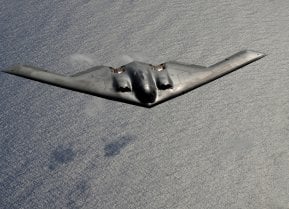The Precision Strike Missile: Meet the Long-Range Killer that China Fears
And it’s only 3 years away.
The F-35 has a publicly disclosed radar cross-section of about half the size of the F-117 Nighthawk, which could potentially double those disclosed detection ranges (depending on the angle of observation and a number of other variables). Based on publicly available data, an F-35 would likely need to fly within 20 miles of the S-400 system in order to be targeted.
With the AARGM-ER’s range likely to be between 96 and 120 miles, this means the F-35 could effectively engage China’s most advanced air defense systems from as much as 100 miles outside their targeting envelope. But, despite this significant advantage, there’s still the issue of getting enough land and sea-based F-35s into range of these systems to take them out. Luckily, America has another stealth platform heading for service that comes with plenty of range and payload capacity to spare: the B-21 Raider.
B-21 RAIDERS CARRYING AARGM-ERS AND SIAWS MAKES FOR A SERIOUS ONE-TWO PUNCH
In the U.S. Air Force’s budget proposal for Fiscal Year 2018, the branch outlined intentions to integrate the Stand-in Attack Weapon (SiAW) into the B-21 Raider – America’s new stealth bomber in active development. With a projected payload capacity of 30,000 pounds or better, the B-21 could potentially carry dozens of SiAWs and AARGM-ER missiles on rotary launchers similar to those employed by the in-service B-2 Spirit.
The B-21’s actual range has yet to be revealed, but Defense officials have already begun touting it as unmatched in the world.
“Let’s talk about the B-21’s range. No other long-range bomber can match its efficiency. It won’t need to be based in-theater. It won’t need logistical support to hold any target at risk,” Defense Secretary Llyod Austin has said. Its predecessor, the B-2 Spirit, boasts an unrefueled range of 6,000 nautical miles (more than 6,900 miles or 9,600 kilometers), and it stands to reason that the B-21 will be able to exceed even that. As a result, America’s intended fleet of more than 100 B-21 Raiders could play a pivotal role in clearing a path for American carriers to close with Chinese shores by flying initial strikes against anti-ship and integrated air-defense systems, engaging hundreds of targets on land and sea with SiAW and AARGM-ER missiles.
Because of the wide array of targets these weapons can engage, B-21 pilots could make tactical decisions in theater regarding which systems to prioritize for their own self-defense as well as for optimal mission accomplishment. And because the B-21 was designed to be optionally manned, these sorties may not even require putting pilots at risk.
By launching this sort of attack in conjunction with other programs, like Rapid Dragon – which would allow cargo aircraft like the C-130 and C-17 to launch dozens of low-observable and long-range cruise and anti-ship missiles from 500 miles out – the United States could lay waste to a large portion of China’s shoreline defenses in short order. With the path cleared for American carriers to sail closer to Chinese territory, more suppression of air defense operations would follow until the airspace became permissive enough for less stealthy platforms to join the fight in a more active way.
But… this approach to warfare is an expensive one, and it’s important to understand the difference between plans and reality.
DETERRING WARS, OVER WINNING THEM
Exploring the ways in which these advanced technologies could give the United States a strategic edge in a large-scale conflict with an opponent like China may paint a rosy picture, but the harsh realities of warfare never live up to our most optimistic expectations. Ultimately, even if the United States manages to field and mass-produce these advanced platforms and weapons in sufficient volume to mount such an offensive, losses are all but certain. Stealth is not invisibility, aircraft and weapons are rarely (if ever) leveraged at maximum ranges, and even advanced systems are prone to fail amid the extreme rigors of combat.
And while this approach could give the United States the advantage in such a conflict, China’s massive military footprint would still present enormous challenges for the American military. In other words, at best, this approach could amount to an incredible opening volley; the war that would follow would be costly for both nations at a scale the world has not seen since the end of World War II.
Therefore, it’s vital to remember that the most valuable use for new weapons like the SiAW, AARGM-ER, and even the stealth aircraft that will carry them isn’t in winning a war. Instead, their best return on investment comes from deterring such a conflict from happening in the first place.
And therein lies the reason Uncle Sam is happy to reveal these developmental efforts, why new fighters and bombers get product-reveals like a new iPhone, and why there’s so much information about America’s military capabilities in the public’s hands. A secret weapon has no strategic value until blood is already being shed, but a disclosed one has the unique power to prevent bloodshed without ever being fired.
Ultimately, there could be no better outcome for all the incredible engineering that goes into weapons like the Stand-in Attack Weapon than never actually having to take it off the shelf.
Alex Hollings is a writer, dad, and Marine veteran.
This article was first published by Sandboxx News.
Image: Shutterstock.


